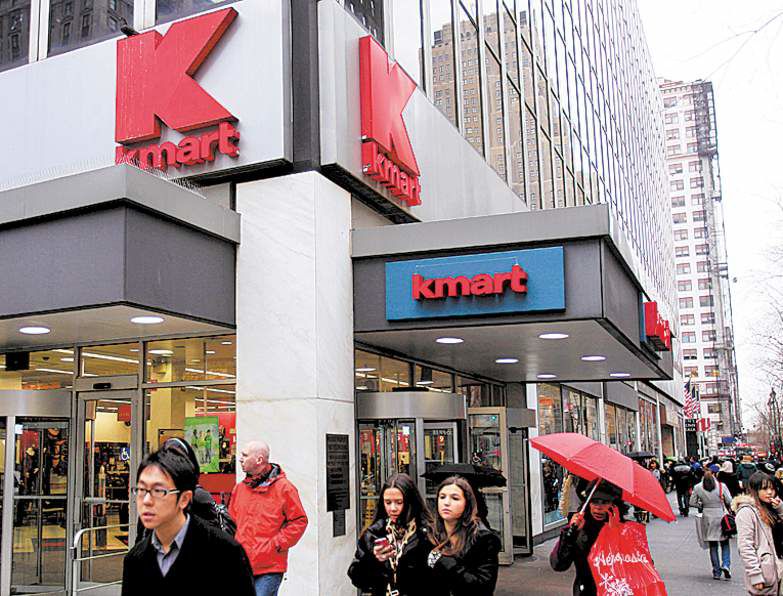Sears Holdings to close up to 120 Sears and Kmart stores
Published 4:00 am Wednesday, December 28, 2011

- Pedestrians pass a Kmart store on Tuesday in New York. Sears Holdings Corp., the parent company of Sears and Kmart department stores, plans to close 100 to 120 stores after a sluggish holiday season.
Christmas was anything but merry for Sears Holdings.
On Tuesday, the retailer, which operates both Sears and Kmart stores, announced plans to shutter up to 120 locations after a sharp drop in sales this holiday season.
While the closures represent a fraction of the total stores, they underscore the retailer’s precarious financial position. The company, which has been slow to renovate rundown stores and improve customer service, expects earnings to fall by more than 50 percent in the fourth quarter, far worse than expected.
“They’re not going out of business tomorrow. But here is a company that is deteriorating in front of our eyes, and it could cost a lot of jobs,” said Gary Balter, an analyst at Credit Suisse. “Somebody should be worried about that.”
Sears has been limping along for years.
In 2005, hedge fund manager Edward Lampert pushed the storied retailer to merge with Kmart, figuring that the combination would wrench savings and bolster profits. His bet drew comparisons to the strategy of Warren Buffett, the chairman of Berkshire Hathaway, who takes concentrated positions in companies that he believes will increase in value and generate cash. Sears Holdings was thought to be something of a Berkshire vehicle — a public entity through which to acquire businesses.
But the merger has been an albatross for Lampert, who is chairman of Sears. Since their 2007 peak, shares in Sears had dropped from $192 to less than $46 in December. On Tuesday, the stock fell 27 percent to close at $33.38.
“The customer just doesn’t think of Sears at the top of their mind anymore,” said Mary Ross Gilbert, a managing director at Imperial Capital.
The weakness stands in contrast to competitors, which have seen a steady improvement in sales. Macy’s, Target and Home Depot have all notched increased revenues through the third quarter. Sears reported a loss during the same period.
Even J.C. Penney, beset with its own woes, shows signs of revitalization. In June, the retailer hired Ron Johnson, the mastermind behind Apple’s retail strategy, as its chief executive. Earlier this month, J.C. Penney bought a stake in Martha Stewart Living Omnimedia, with plans to introduce ministores around the home brand. Shares of J.C. Penney are up 10 percent this year.
Rough year
The holiday season has been especially dark for Sears. So far this quarter, same-store sales are off 5.2 percent at Sears and Kmart locations that have been open for more than a year. By comparison, the industry is expecting to see holiday sales rise 3.8 percent, according to the National Retail Federation.
Sears’ main customer base — typically more working class — has been hit hard in the current economic climate. Many have put off big-ticket purchases like home appliances until the employment outlook improves.
“Sears is one of the top appliance sellers in the United States,” said Paul Swinand, an analyst at Morningstar. But “appliances and electronics have been doing poorly since the recession.”
When the environment does improve, analysts say consumers could still shun Sears. Its uninviting stores and out-of-the-way locations remain a major challenge, and Sears has not invested in overhauling its look.
The company shells out about 1 percent of revenue on capital expenditures. Competitors like Target, Wal-Mart, Lowes and Home Depot, meanwhile, spend closer to 2 percent to 3 percent on facilities.
A better balance sheet
With sales slumping, Sears is looking to shutter stores to save money. The closures are expected to generate up to $170 million as the company sells off inventory. Sears also plans to adopt a more mercenary approach to closings going forward, rather than trying to improve “marginally performing stores” as the company has done in the past.
It’s part of a broader effort to bolster its balance sheet. Sears plans to reduce its overall inventory, which could bring in another $300 million. It plans to cut fixed costs, which could include rental and administrative expenses, by up to $200 million.
“These actions will better enable us to focus our investments on serving our customers and members through integrated retail — at the store, online and in the home,” Lou D’Ambrosio, the company’s chief executive, said in a statement.
But analysts are not convinced such efforts will be enough. For one, Sears has hefty pension and retirement burdens, which will continue to drain cash. And the company has already tapped a line of credit for $483 million, which it hadn’t done at this time last year.
“I think they are a lot worse than people were thinking,” said Ross Gilbert of Imperial Capital. “They are really close to a liquidity crisis.”






